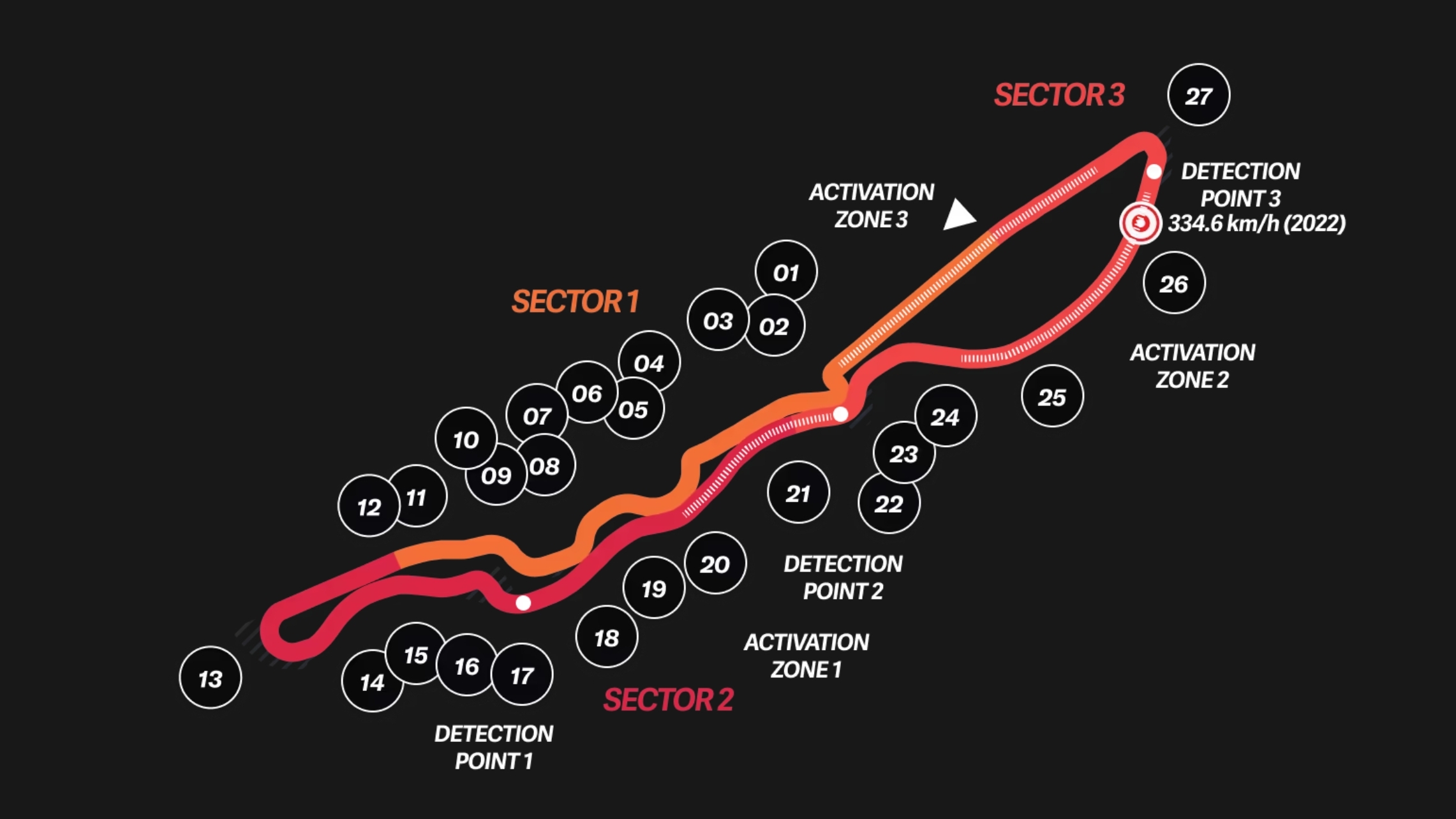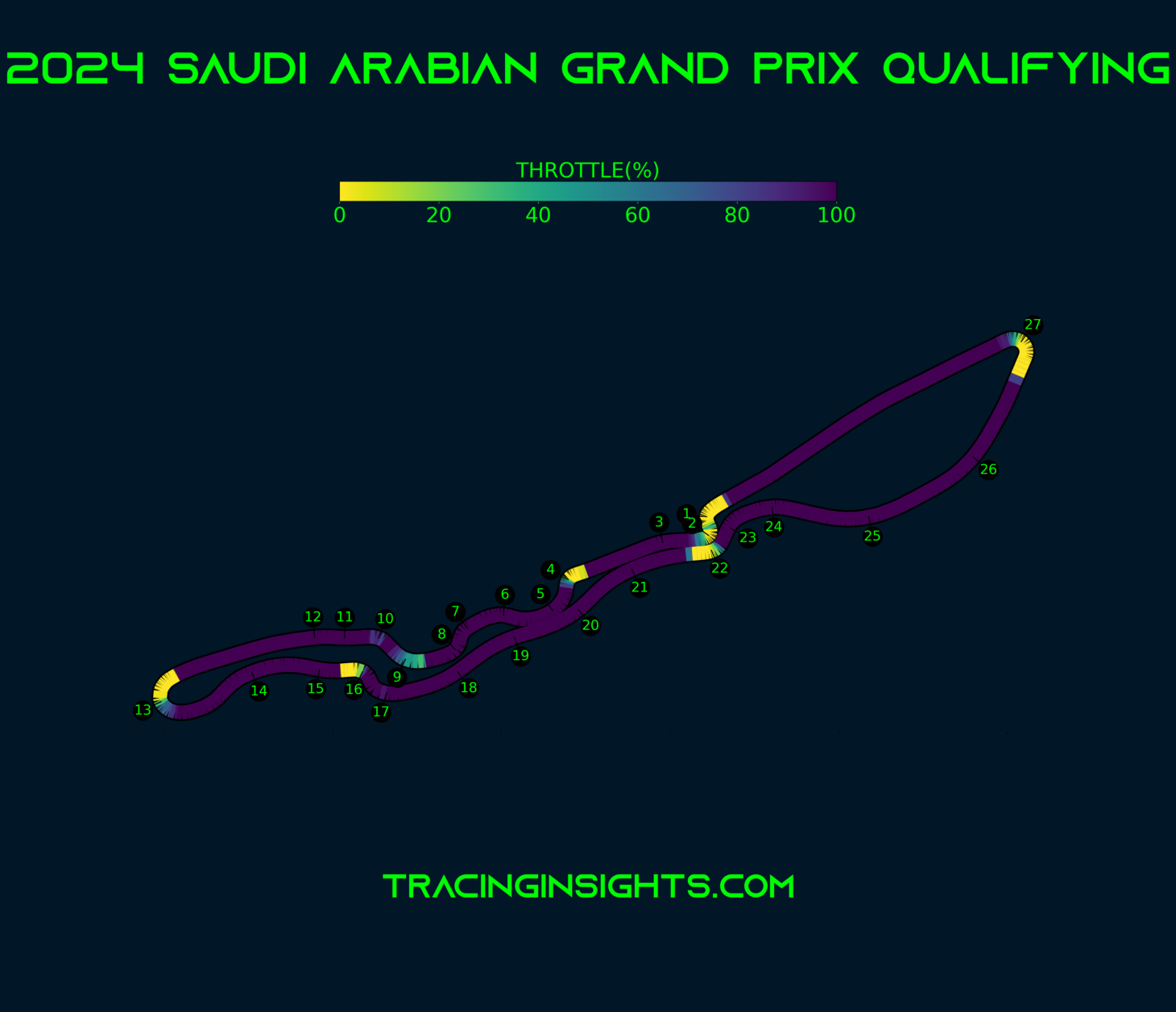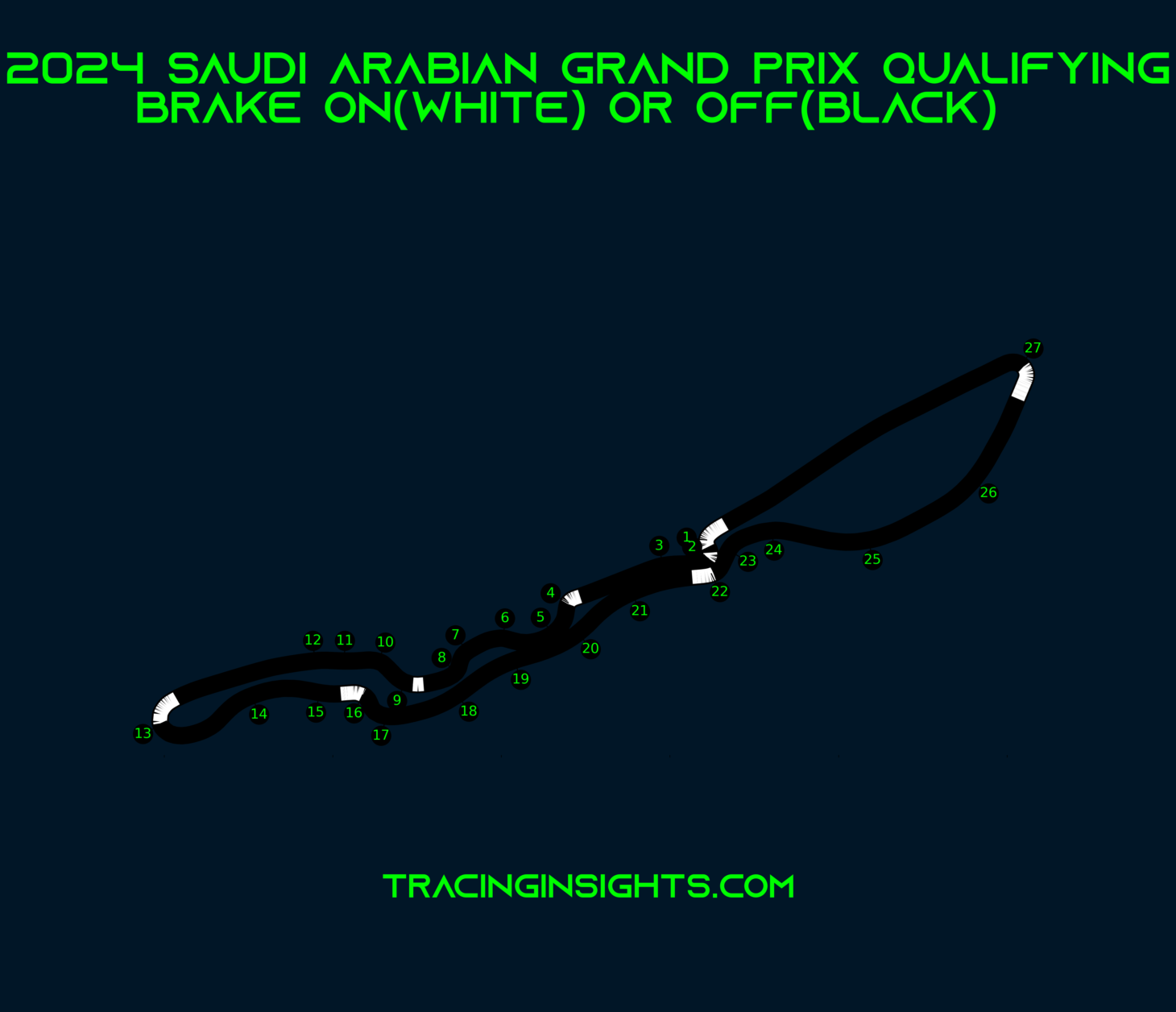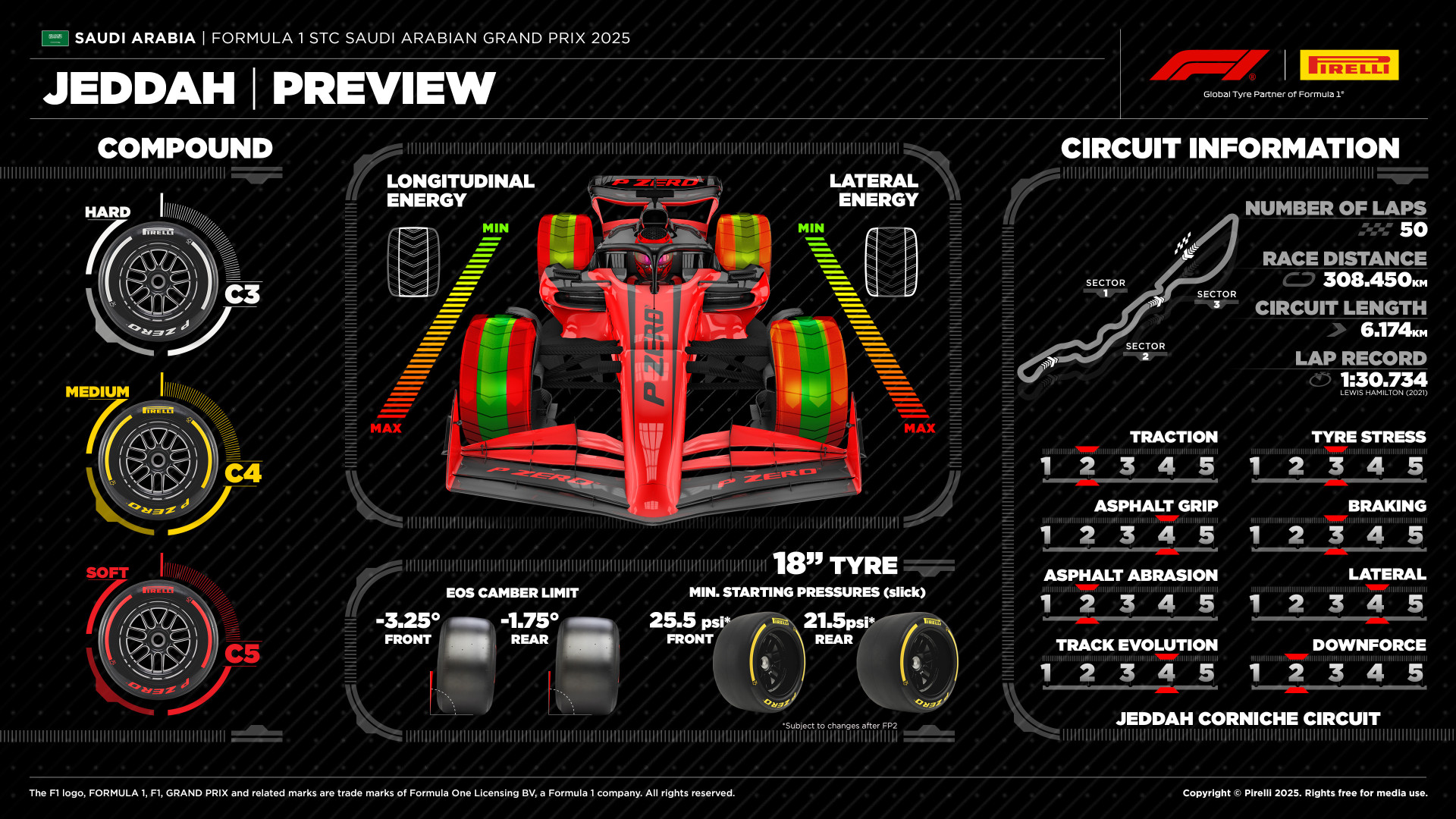
ALL YOU NEED TO KNOW - 2025 SAUDI ARABIAN GRAND PRIX
Table of Contents
Anatomy of Speed: Dissecting Jeddah's 6.174km Ribbon – Featuring 27 Unique Corners, High-Speed Flow, Critical 12% Banking at T13, Minimal Braking Zones, and an 80% Full-Throttle Lap Profile
In a remarkably short time, the Jeddah Corniche Circuit has carved out an identity all its own, quite distinct from the mainstream. It's a street circuit that rewrites the playbook, lacking the usual stop-start tropes. It boasts blistering high speeds and flowing banked corners, rather than a preponderance of tight, second-gear turns. It does have the ever-present drama of barriers hugging the track, ready to punish the slightest error on a flying lap – but it isn't a circuit where Qualifying position dictates the outcome. This is emphatically a track layout built for racing: plentiful overtaking zones invite bold moves lap after lap – yet the penalty for over-ambition is severe, with mistakes carrying enormous consequences. This potent mix makes the Saudi Arabian Grand Prix absolutely mesmerizing to watch, a race where leads can evaporate and fortunes transform in an instant.

Circuit History
The Saudi Arabian Grand Prix takes place in Jeddah, a significant port city on the Red Sea, known as a gateway for pilgrims heading to Mecca and a major commercial and cultural centre featuring a modern waterfront and the historic Al-Balad district. This event marks the conclusion of the first triple-header of the 2025 season.
The race debuted on the Formula 1 calendar in December 2021 as the penultimate round of that season. Since then, it has consistently occupied an early-season slot, being held in March for the subsequent three editions (2022, 2023, 2024). The 2025 running marks the first time the event will be held in April. This later date might introduce temperature, wind, and humidity levels more akin to summer conditions compared to previous years, influencing on-track activities. When Saudi Arabia joined the calendar, it became the 75th different venue to host a Formula 1 Grand Prix.
Circuit Characteristics and Challenges
The Jeddah Corniche Circuit, as its name implies, features a long section following the coastline. It presents a unique challenge, often described as a street circuit that lacks the typical street-circuit characteristics.
-
Layout and Dimensions: At 6.174km, it is the third-longest circuit on the F1 calendar, surpassed only by Las Vegas and Spa-Francorchamps. It boasts the most corners of any track currently visited, with 27 turns (16 left, 11 right).
-
High-Speed Nature: Despite the high corner count, Jeddah is exceptionally fast. It's often called the fastest street circuit on the planet. Average speeds during a race lap hover around 250 km/h, a figure comparable to Monza. Only Monza itself features a higher average speed across the entire calendar. Initial simulations suggested top speeds exceeding 320 km/h near Turn 27, with potential average lap speeds over 260 km/h. The 2021 pole lap average was just under 254 km/h.
-
Flowing Design: Unlike traditional street circuits dominated by 90-degree, low-speed turns, Jeddah features flowing corners taken at medium or high speed, often passing extremely close to the walls. It has been likened to a longer, faster Circuit Gilles Villeneuve in Montréal.
-
Throttle Application: Almost 80% of the lap is spent at full throttle. Only Albert Park in Melbourne and Monza record higher figures. It’s a layout that really rewards strong power unit performance and sharp aerodynamic efficiency.

-
Track Surface and Grip: The tarmac itself is smooth and not particularly abrasive, leading to generally low tyre degradation. However, the numerous high-speed corners generate considerable lateral forces on the tyres, though perhaps not to the extreme levels seen at circuits like Suzuka or Barcelona.
-
Environmental Factors: Its waterfront location means sand blowing onto the track is an issue, similar to Abu Dhabi. Changes in wind direction between daytime practice and evening sessions (Qualifying, Race) can also affect car balance and performance.
-
Car Demands: The high speeds, sustained full-throttle running, and ambient heat place demands on power unit systems, brakes, and tyres. The non-stop nature requires significant performance from the engine and associated power components.
TRACK CHARACTERISTICS
TRACTION
2/5
TYRE STRESS
3/5
ASPHALT GRIP
4/5
BRAKING
3/5
ASPHALT ABRASION
2/5
LATERAL
4/5
TRACK EVOLUTION
4/5
DOWNFORCE
2/5
Key Corners
The circuit's 27 corners present a continuous challenge:
-
Sector 1: Begins with a rapid run into the Turn 1/Turn 2 left-right chicane. Turn 2 is the slowest corner on the circuit, negotiated at approximately 80 km/h. The anti-clockwise lap features a high-speed, rapid-change of direction sequence. This sector then flows into a complex of 10 quick direction changes testing car and driver agility.

-
Turn 13: A defining feature is the banked left-hand hairpin. With a 12% gradient (seven degrees less than Zandvoort's banking), it allows for multiple lines and helps drivers build momentum onto the subsequent high-speed section running south along the coast.
-
Sector 2: Kicked off by Turn 13, this sector features another relentless run of fast corners, including the sweeping curves within the second DRS zone.
-
Fastest Sections: Turns 20, 21, and 26 are highlighted as the quickest corners, taken at speeds around 300 km/h.
-
Turn 27: The final corner is another hairpin, slightly banked, leading onto the main start-finish straight. It follows a DRS zone and features a dramatic braking zone, making it a key area for action. The subsequent start-finish straight is the longest of the three DRS sectors, representing the prime overtaking spot on the track as drivers approach the lowest-speed corner at Turn One
Braking Demands
While much of the lap is taken flat-out, specific braking events are critical:
-
Frequency and Severity: There are only seven distinct braking points per lap: two classified as heavy, two medium, and three light. Drivers spend only around 15% of the lap time applying the brakes.
-
Most Demanding Zones: Turns 1, 27, and 22 are considered the most demanding corners for the braking system.
-
Deceleration Example: The approach to Turn 1 requires significant braking force, slowing the cars from approximately 317 km/h down to 110 km/h.
-
Heat Factor: The ambient heat in Jeddah can put additional strain on the braking systems, potentially affecting performance and wear over the race distance.
F1 BREMBO BRAKING DATA – SAUDI ARABIAN GP 2025
| Turn | Initial Speed (km/h) | Final Speed (km/h) | Stopping Distance (m) | Braking Time (sec) | Maximum Deceleration (g) | Maximum Pedal Load (kg) | Braking Power (kW) |
|---|---|---|---|---|---|---|---|
| ≡ 01 | 317 | 110 | 122 | 2.47 | 4.4 | 159 | 2,339 |
| _ 02 | 116 | 86 | 29 | 1.05 | 2.1 | 79 | 391 |
| ≡ 04 | 265 | 160 | 67 | 1.19 | 4.2 | 156 | 1,980 |
| _ 07 | 279 | 242 | 43 | 0.60 | 2.7 | 60 | 811 |
| ≡ 13 | 301 | 177 | 94 | 1.55 | 4.1 | 140 | 1,980 |
| ≡ 16 | 288 | 211 | 52 | 0.79 | 4.4 | 158 | 2,144 |
| ≡ 22 | 311 | 195 | 76 | 1.14 | 4.4 | 158 | 2,270 |
| ≡ 27 | 322 | 127 | 120 | 2.31 | 4.4 | 158 | 2,320 |
Pit Lane and Technical Features
The pit lane configuration plays a role in strategy:
-
Length: Jeddah's pit lane is the fourth shortest on the F1 calendar.
-
Time Loss: Despite its relatively short length, the time spent transiting the pit lane during a stop is minimal. It's ranked as the second shortest time loss of the season, at only around 15 seconds. This low penalty makes pitting strategically advantageous, especially under caution periods.
-
Historical Stop Count: Interestingly, despite the low time penalty, the track hasn't historically seen a high volume of pit stops. Across the first four races, only 64 pit stops were recorded in total, averaging just four-fifths of a stop per driver per race.
Overtaking Opportunities
While Jeddah is fast and flowing, overtaking requires calculation:
-
DRS Zones: Three DRS zones are implemented to aid overtaking:
-
The main start-finish straight.
-
The section between Turns 20 and 22 (detection before T20).
-
The run towards Turn 27 (detection after T24). Jeddah is one of only three circuits (along with Bahrain and Austria) to feature three DRS zones.
-
-
Key Overtaking Spots: The lack of heavy braking zones limits clear-cut passing opportunities. Turn 1, following the longest DRS zone and being the slowest corner, is considered the prime overtaking spot. The braking zone into the final corner, Turn 27, also provides opportunities for wheel-to-wheel action.

-
Run to Turn 1: The distance from pole position to the first braking point at Turn 1 is the fourth-shortest of the season, behind only Spa, Baku, and Las Vegas.
-
Strategic Positioning: The track layout encourages positional chess. Drivers might sometimes prefer not to take the lead on the back straight sections, instead aiming to secure DRS activation for the main straight to make a move into Turn 1 and then use the subsequent 17 corners to build a gap before the next detection point.
Racing Considerations
Several factors influence the nature of racing at Jeddah:
-
Safety Cars and Interruptions: The circuit has a high probability of incidents leading to interventions. Across the four races held (2021-2024), there have been five full Safety Car periods and two red flags. The 2021 race was particularly chaotic with multiple SCs, red flags, and VSCs. While the last two editions (2023, 2024) each featured only one Safety Car, the high speeds and proximity of walls mean teams must factor cautions into their strategies (Jeddah holds a 100% Safety Car intervention record over its history). Being prepared is crucial, as demonstrated by Pérez losing a potential win in 2022 due to ill-timed SC deployment.
-
Risk vs. Reward: Jeddah is characterized as one of F1's biggest risk/reward circuits. The high speeds and unforgiving barriers demand boldness and precision. Small mistakes are heavily punished, but calculated risks can yield significant gains. Fortunes can change instantly.
-
Energy Management: The long lap (6.174km) with its numerous corners means energy management – how harvesting (ERS-K) and deployment (ERS-H) are optimized – can be very important for overall lap time and race performance.
Tyre Selection and Strategy
Tyre management and strategy are key, especially with the 2025 compound changes:
-
2025 Compound Allocation: For the first time since its debut, Pirelli has altered the tyre allocation for Jeddah. Moving one step softer than previous years, the compounds available for 2025 are the C3 (Hard), C4 (Medium), and C5 (Soft). This decision, made with the FIA, F1, and teams, aims explicitly to create more strategic choices and unpredictable racing.

-
Historical Strategy (Pre-2025): In the four previous editions (using C2 Hard, C3 Medium, C4 Soft), the one-stop strategy, typically Medium (C3) to Hard (C2), overwhelmingly dominated both in terms of effectiveness and team preference. Safety Car timings often dictated the pit stop window for this strategy.
-
Soft Tyre Usage (Historical): The Soft compound (previously C4) saw very limited race use, completing only 101 racing laps in total across the first four events.
-
Potential 2025 Strategies: While the C4-C3 combination likely still offers the range for a one-stop, the introduction of the C5 Soft brings the two-stop strategy more firmly into play. The viability of using the Soft tyre for a race stint, as demonstrated by a few drivers in 2024, might increase.
-
Tyre Behaviour & Challenges:
-
Graining: Can occur, particularly in early practice sessions when the track surface is 'green' (lacking rubber). However, track evolution throughout the weekend, aided by support races, usually reduces this phenomenon. The softer 2025 compounds might reintroduce or exacerbate graining concerns.
-
Degradation: Generally low due to the smooth surface, allowing drivers to push hard for extended periods. Thermal degradation, though reduced in the 2025 tyre range, will still be a factor, especially with the softer C5.
-
Tyre Preparation: Getting tyres into the correct temperature window for qualifying has historically been tricky at Jeddah, often requiring multiple warm-up laps. The availability of the C5 might make this process more straightforward in 2025.
-
Last Year's Strategic Picture (2024)
The 2024 race provided specific examples of tyre usage under the previous C2/C3/C4 allocation:
-
Dominant Strategy: The vast majority of the field opted for a one-stop strategy, starting on the C3 Medium tyre and switching to the C2 Hard tyre for the second stint. Max Verstappen won using this strategy, pitting on lap 7 during a Safety Car caused by Lance Stroll's incident, which triggered a rush to the pits. 14 of the 18 finishers mirrored this approach.
-
Alternative Starts: Only Valtteri Bottas (Sauber) and Oliver Bearman (Ferrari) started the race on the C4 Soft tyre, attempting to utilize its initial grip advantage.
-
Alternative Strategy: Lando Norris (McLaren), Lewis Hamilton (Mercedes), and Zhou Guanyu (Sauber) extended their first stint on the Medium tyre significantly before switching to the Soft tyre for the final part of the race, proving the Soft could function as a viable race tyre.
-
Two-Stopper: Valtteri Bottas was the only driver to execute a planned two-stop strategy.
Weather Outlook and Its Impact
Weather conditions play a role, particularly given the location and timing:
-
Sand and Wind: As mentioned, the coastal location makes blowing sand a potential factor affecting grip levels. Wind direction can also shift between day and night sessions.
-
Temperature and Humidity: The move to an April date for 2025 might bring conditions closer to summer levels (warmer, more humid) than the previous March races. The provided text includes a forecast for a race weekend (potentially referring to the 2025 event contextually) predicting highs of 37/38°C and lows of 27°C. Such heat, especially on the narrow track with barriers limiting airflow, could make daytime practice sessions (FP1, FP3) punishing and the evening sessions (FP2, Qualifying, Race) uncomfortable for drivers over the ~1h20m race duration. Heat also adds stress to car components like brakes.
-
Historical Factor: Across the first four editions, weather hasn't been a decisive factor in race outcomes, but the potential exists, especially with the date change.

Historical Records and Statistics
The Saudi Arabian Grand Prix has generated several notable statistics in its short history:
-
Race Editions: 2025 marks the fifth edition of the event, all held at the Jeddah Corniche Circuit.
-
Most Wins (Driver): Max Verstappen leads with two victories (2022, 2024). Lewis Hamilton won the inaugural race (2021), and Sergio Pérez won in 2023.
-
Most Wins (Team): Red Bull Racing holds the most victories with three (Verstappen x2, Pérez x1). Mercedes won the first race.
-
Most Poles: Sergio Pérez has the most pole positions with two (2022, 2023). His 2022 pole was his career-first and the first ever for a Mexican driver in F1. Hamilton (2021) and Verstappen (2024) have one pole each. Three out of four races have been won from pole position.
-
Podium Milestones: Both Max Verstappen (2024 win) and Fernando Alonso (2023 third place for Aston Martin) achieved their 100th F1 podium finish in Saudi Arabia.
-
Fastest Laps: Charles Leclerc holds the record for the most fastest race laps here, with two. He has also finished in the top three twice.
-
Points Leaders (at Jeddah): Max Verstappen leads with 87 points scored at this track, followed by Sergio Pérez (55) and Charles Leclerc (49).
-
Debut: Oliver Bearman made his F1 debut here in 2024 for Ferrari, substituting for Carlos Sainz. He became the youngest British driver and youngest Ferrari driver in F1 history, finishing P7.
-
Team Milestone: The 2025 race marks Aston Martin's 100th Grand Prix start (combining their 1959-60 entries with their return from 2021 onwards).
-
F2 Experience: Several 2025 drivers have prior experience here in FIA Formula 2, including Jack Doohan (Alpine), Liam Lawson and Isack Hadjar (Racing Bulls), Gabriel Bortoleto (Sauber), and Andrea Kimi Antonelli (Mercedes). Lawson is the only one among them with a win here (2021 F2 Sprint Race).
-
Race Distance: The race is scheduled for 50 laps, covering a total distance of 308.75 km.
-
Lap Record: Max Verstappen holds the outright lap record, a 1:27.472 set during Q3 in 2024, at an average speed of 254 km/h.
2025 Saudi Arabian Grand Prix – Stat Sheet
Circuit Characteristics
| Characteristic | Value |
|---|---|
| Circuit Length | 6.174 km |
| Race Laps | 50 |
| Race Distance | 308.5 km |
| Number of Corners | 27 (16 L / 11 R) |
| Distance from Pole to First Braking Zone | 148 m |
| Pole Position Side | Right |
| Pit Lane Length Under Speed Limit Control | 337 m |
| Drive-Through Time at 80 km/h | 15s |
| Lap Time At Full Throttle | 70% |
| Lap Distance At Full Throttle | 76% |
| Gear Changes Per Lap | 42 |
| Braking Events (>2G) | 6 |
| Heavy Braking Events (<0.4s @ >4G) | 2 |
| Braking Energy | Medium |
| Maximum Lateral G-Force | 4.8 (T8) |
| Maximum Speed | 329 km/h |
| Fuel Consumption | Medium |
| DRS Zones | T20–22, T25–27, T27–1 |
| Key Overtaking Opportunities | T1, T27 |
2024 Statistics
| Statistic | Value |
|---|---|
| Fastest Lap FP1 | 1:29.659 |
| Fastest Lap FP2 | 1:28.827 |
| Fastest Lap FP3 | 1:28.412 |
| Fastest Lap Q1 | 1:28.171 |
| Fastest Lap Q2 | 1:28.033 |
| Fastest Lap Q3 | 1:27.472 |
| Delta FP1 to Q3 | -2.187s |
| Delta Q1 to Q3 | -0.699s |
| Podium | VER / PER / LEC |
| Team Result | RUS P6 / HAM P9 |
| Fastest Race Lap | 1:33.706 (VER) |
| Winning Race Time | 1:20:43.273 |
| Winning Average Speed | 237 km/h |
| Qualifying Speed Trap | 338 km/h (HUL) |
| Race Speed Trap | 341 km/h (SAR) |
| Winning Strategy | 1 Stop (L7) |
| Total Pit Stops | 19 |
| Total Normal Overtakes | 6 |
| Total DRS Overtakes | 15 |
| Race Lap Record | 1:30.734 (HAM, 2021) |
| Absolute Lap Record | 1:27.472 (VER, Q3, 2024) |
| Not Classified (Accident/DSQ) | 1 |
| Not Classified (Mechanical) | 1 |
Race Characteristics (2021–2024)
| Characteristic | Value |
|---|---|
| Races Featuring Safety Car | 4/4 |
| Total Safety Car Deployments | 5 |
| Safety Car Probability | 100% |
| Safety Car Ratio | 1.3 |
| Wet Sessions | 0/25 |
| Wet Session Probability | 0% |
| Average Track Temperature | 28°C |
| Maximum Track Temperature | 31°C |
| Average Ambient Temperature | 26°C |
| Maximum Ambient Temperature | 28°C |
| Ambient Pressure | 1011.6 hPa |
Tyre Allocation
| Compound | Sets Per Driver |
|---|---|
| Soft | 8 |
| Medium | 3 |
| Hard | 2 |
Driver Perspective and Demands
Jeddah places unique demands on the drivers:
-
Confidence is Key: On a high-speed track with minimal runoff and close walls, driver confidence is crucial. A predictable car balance allows drivers to build confidence during practice, pushing closer to the limits lap by lap. This is fundamental to extracting maximum performance.
-
Practice Importance: Sufficient track time is vital due to the steep learning curve compared to traditional circuits. FP2 is the most critical session as its evening timing mirrors qualifying and race conditions (track temperatures dropping 10-15°C from FP1/FP3), allowing for representative setup work. Engineers must anticipate this temperature drop's effect on car balance.
-
Physical and Mental Strain: The relentless sequence of corners means the steering wheel is rarely straight. Drivers experience continuous G-forces even on sections that appear straight to spectators. This makes the circuit physically tiring and mentally demanding for managing steering inputs, car adjustments via wheel switches, and radio communication. Practice helps drivers get comfortable with this workload.
-
Qualifying vs. Race Trim: Drivers must adapt to the significant difference in car behaviour between low-fuel qualifying runs (where some corners might be power-limited) and high-fuel race stints (where those same corners can become grip-limited).
-
Setup Direction: Teams often opt for lower-drag rear wing configurations compared to higher-downforce tracks, aiming for aerodynamic efficiency and strong top speeds suitable for Jeddah's layout.
-
Maximum Focus: The combination of extremely high speeds (reaching 341 km/h in the 2024 speed trap) and the unforgiving nature of the track requires immense concentration throughout every lap. Tiny lapses can lead to significant incidents. Precision is paramount, likened to "threading the eye of a needle."
Venue and Spectator Experience
The setting contributes to the event's character:
-
Waterfront Location: The circuit runs along the Red Sea Corniche, offering a stunning backdrop, particularly with the yacht-lined sections visible during broadcasts.
-
Night Race Spectacle: Racing under lights enhances the visual drama.
-
Grandstand Views: Grandstands are primarily clustered on the landward side. Many offer views over multiple sections of the long, narrow track. Main Grandstand B is highlighted for overlooking the Turn 1/2 chicane, starting grid, and pit lane entry – areas known for action.
-
Busy Schedule: The event features a packed schedule with support races like Formula 2 and F1 Academy running from lunchtime through to the evening, offering extensive track action for attendees.
Where to Watch 2025 Saudi Arabian Grand Prix
I’m constantly changing things up to make this newsletter more useful, so let me know what you think by commenting below. I read every reply! Please do reply. I'm not a robot, I talk back.
Follow me on Whatsapp, Telegram, Facebook, YouTube, LinkedIn, Pixelfed, Tumblr, Bsky, Twitter, Mastodon, Instagram, Sub-Reddit, Threads for more analysis
Follow me on Whatsapp, Telegram, Facebook, YouTube, LinkedIn, Pixelfed, Tumblr, Bsky, Twitter, Mastodon, Instagram, Sub-Reddit, Threads for more analysis!